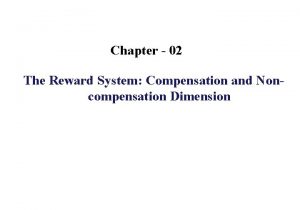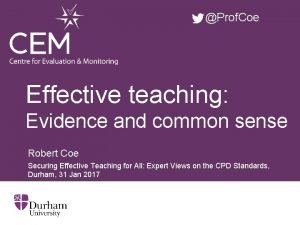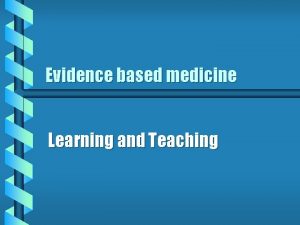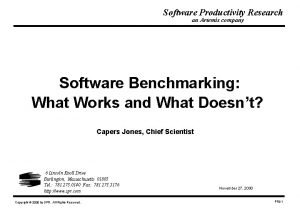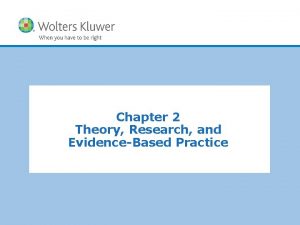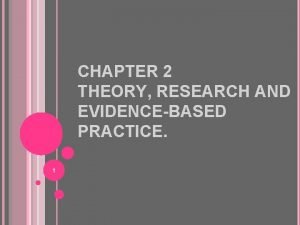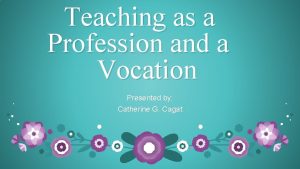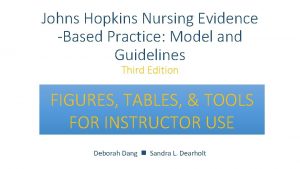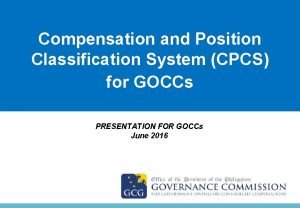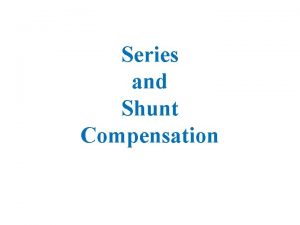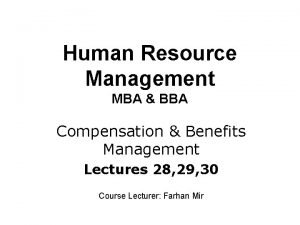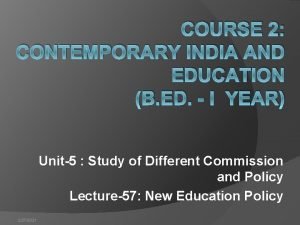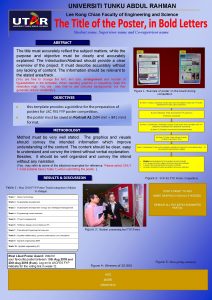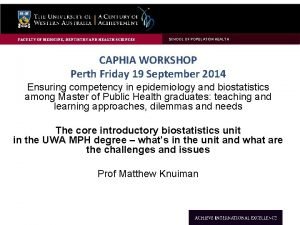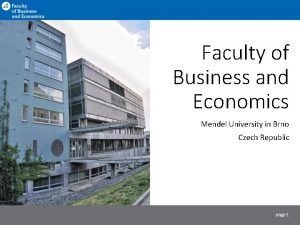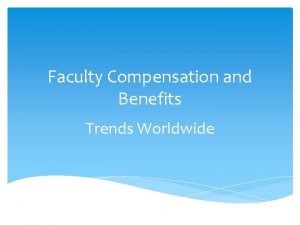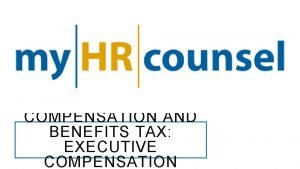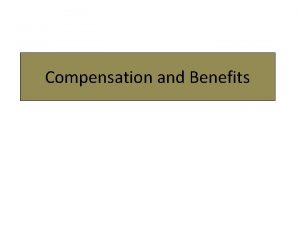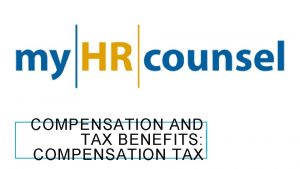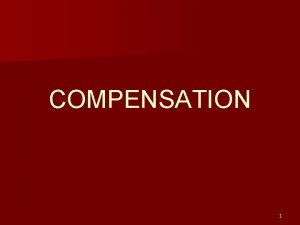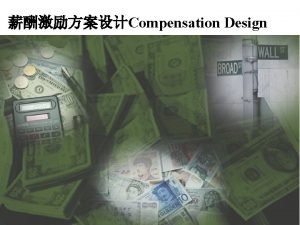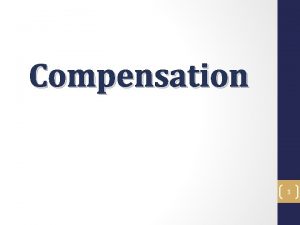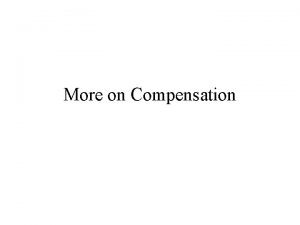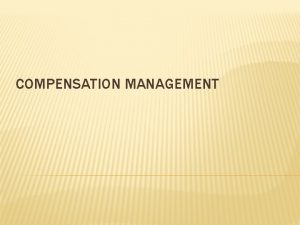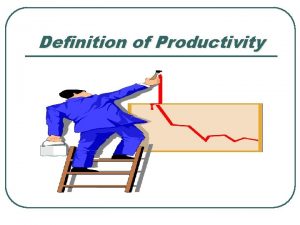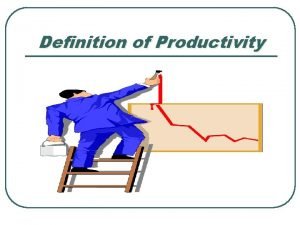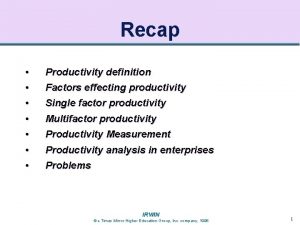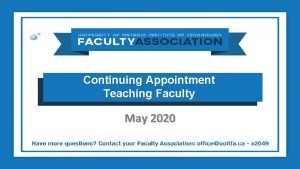Research Productivity Teaching Productivity and Faculty Compensation Evidence

































- Slides: 33

Research Productivity, Teaching Productivity, and Faculty Compensation: Evidence from U. S. Universities James D. Adams J. Roger Clemmons NBER-SEWP Conference October 20, 2005

Five Goals l Goals: 1. 2. 3. 4. 5. 2 To conduct a thought experiment on the university & its role in faculty choice. To provide evidence on research and teaching productivity in top U. S. universities. To compare productivity in private and public, top 10 and non-top 10 universities. To describe sources of productivity growth in aggregate productivity growth. To explain research & teaching productivity and compensation at the university level.

Why is Any of this Important? l Do U. S. universities contribute to U. S. R&D firms? – l l Costly to replicate top university assets once dismantled. The “Bell Labs” question—should we regret its loss? – 3 “Industrial Scientific Discovery” (Adams & Clemmons, October 2005) says “yes”. NRC study (Strengthening U. S. Telecomm Research) says “yes, ” because technical progress has fallen since.

A Thought Experiment l l 4 Faculty teach and provide research. But who do they work for? For teaching the answer is usually clear—the school. And yet research faculty cultivate many clients, more as the life cycle progresses. The university is like a business incubator. It is arms length in its handling of faculty.

Sketch of the Faculty Member’s Problem l l 5 Accordingly suppose that faculty have freedoms that workers in “real” jobs lack. Faculty maximize utility subject to personal production functions and an effort constraint. They derive satisfaction from income and effort for enjoyment’s sake, but are motivated by net prices for research and teaching. Choice variables are the effort vector and variable complementary inputs.

Model l Problem is to maximize the Lagrangian, l Subject to The resulting optimal supplies of output are l 6 .

Implications l l l 7 Output increases with university efficiency, with output price, with faculty talent, but decrease with complementary input price. Compensation is an additive function of net income from research and teaching. It responds to both sets of determinants and increases with optimal output supplies.

University Constraints (1) l l l 8 Faculty rely on fixed or shared inputs— libraries, heating and other utilities, parking, students, top university governance. These costs must be covered—hence the necessity of the overhead rate. But the overhead rate distorts faculty incentives, though it supports the institution.

University Constraints (2) l l l 9 The market sets gross prices, but net prices depend on the overhead rate. This must satisfy a solvency constraint. Net of payments to faculty and variable complementary inputs, the constraint is Here t is the overhead rate and F is fixed cost.

Empirical Work: Construction of Faculty-Equivalents l l 10 We start with estimates of teaching and research faculty in top U. S. Universities. Use undergraduate and graduate degrees as teaching outputs—for now. Construct research outputs—papers and citation-weighted papers. Build teaching and research labor productivity indicators using these data.

Trends in Faculty, 1981 -1999 l l 11 Tenure-track faculty grow at 0. 6% per year. Research faculty grow at 1. 3%, teaching faculty at 0. 2%. Adjunct faculty, graduate student-teachers-not well measured in the data. Private university faculty grow at 1. 2%, public university faculty at 0. 5%.

Separability Hypothesis Concerning Research and Teaching l l 12 Suppose that teaching and research are separable production activities. Teaching effort does not produce research, research effort does not produce teaching. This is a reasonable assumption for undergraduate teaching. It is more accurate than assuming the same effort jointly produces both outputs.

Problem #1: Joint Research and Teaching Justus von Liebig l l 13 Ever since Justus von Liebig graduate research & teaching have tended to be jointly produced. But most teaching is undergraduate & some graduate teaching does not involve research. Perhaps separability is the more accurate assumption. Also, graduate and undergraduate teaching expenditures are combined in the data.

Problem #2: Human Energy Constraints & Incentives Adam Smith l l Energy constraints—research and teaching entail a tradeoff, subject to incentives. Adam Smith emphasized this problem: “The endowments of schools and colleges have necessarily diminished more or less the necessity of application in the teachers. …In the University of Oxford, the greater part of the public professors, have, for these many years, given up altogether even the pretence of teaching. ” The Wealth of Nations (p. 717 -718, Mod. Lib. Ed. ) 14

Research and Teaching Productivity 15 l Proceeding with the separability assumption, we construct twin indexes of labor productivity: l Research and teaching outputs are divided by faculty equivalents.

Trends in Research and Teaching Productivity, 1981 -1999 l l Next we compute productivity trends. For research we find that: – – l For teaching we find that: – – 16 Papers per research faculty grow at 1. 5% Citations per research faculty grow at 6. 6% BA degrees per instructional faculty grow at 0. 8% All degrees per instructional faculty grow at 0. 9%.

Trends in Graphical Form l l l 17 Graphs show trends in faculty and productivity by type. Research faculty grow faster in public universities, but research productivity grows faster in private universities. Teaching productivity grows faster in public universities, but teaching faculty grow faster in private universities.

18

19

20

21

22

23

Sources of Aggregate Productivity Growth among Universities 24 l Next we examine the sources of productivity growth. This analysis employs a formula from Haltiwanger et alia (2001): l Results are shown on the next slide.

25

Regression Analysis of Research Productivity l l 26 We also estimated production functions for research in labor productivity form. Table 7 reports the results. The lagged stock of R&D is significant, but this and other inputs are sensitive to the inclusion of university fixed effects. There is evidence of decreasing returns to scale to research at the university level.

27

Regression Analysis of Teaching Productivity l l 28 We undertook a similar analysis of teaching productivity. Results are shown in Table 9. Graduate students per faculty play a role in undergraduate degrees (but only in public universities). As expected, student inputs are significant. Decreasing returns to scale are much weaker than in the research productivity regressions.

29

Regression Analysis of Faculty Compensation l l l 30 Finally we explore determinants of faculty compensation—salary plus fringes. Because compensation depends on the sum of net values of output in both research and teaching, all variables are expressed in log deviations from the mean of the sample. Results are shown in Table 11 below.

31

Discussion of Compensation Results l l l 32 Compensation usually rises faster than productivity (compare trends). Compensation rises with research productivity, but falls with undergraduate teaching productivity. Selective forces and the allocation of effort away from more highly valued skills drive this last result.

Conclusions l l 33 This paper seeks to explain the university in terms of applied microeconomics and to study its growth. An empirical survey suggests that growth is slow and proceeds with allocative inefficiency. Slow growth related to budget problems, to opportunities in industry that raise wages. More work needed—especially on value of teaching output and use of part-time faculty.
 Noncompensation
Noncompensation How can class evidence have probative value
How can class evidence have probative value Effective teaching evidence and practice
Effective teaching evidence and practice Micro teaching is a scaled down encounter
Micro teaching is a scaled down encounter Primary evidence vs secondary evidence
Primary evidence vs secondary evidence Primary evidence vs secondary evidence
Primary evidence vs secondary evidence Secondary sources
Secondary sources Primary evidence vs secondary evidence
Primary evidence vs secondary evidence Jobs vancouver
Jobs vancouver Why are fibers considered class evidence
Why are fibers considered class evidence Class evidence vs individual evidence
Class evidence vs individual evidence Class vs individual evidence
Class vs individual evidence Ecological fallacy definition
Ecological fallacy definition Evidence based teaching
Evidence based teaching Software productivity research
Software productivity research Theory research and evidence based practice
Theory research and evidence based practice Evidence based theory
Evidence based theory Teaching is a vocation what does this mean
Teaching is a vocation what does this mean John hopkins evidence-based practice model
John hopkins evidence-based practice model Cms compensation rules for msa and pdp
Cms compensation rules for msa and pdp Gocc salary grade 2021
Gocc salary grade 2021 Shunt compensation
Shunt compensation Designing and managing incentive compensation programs
Designing and managing incentive compensation programs Starbucks vacation payout
Starbucks vacation payout Mba compensation and benefits
Mba compensation and benefits Faculty of medicine nursing and health sciences
Faculty of medicine nursing and health sciences Lee kong chian faculty of engineering and science
Lee kong chian faculty of engineering and science Mendel university - faculty of business and economics
Mendel university - faculty of business and economics University of debrecen faculty of economics and business
University of debrecen faculty of economics and business Faculty of economics and business zagreb
Faculty of economics and business zagreb Motivated energized and capable faculty
Motivated energized and capable faculty Lee kong chian faculty of engineering and science
Lee kong chian faculty of engineering and science Pubh4401
Pubh4401 Mendel university faculty of business and economics
Mendel university faculty of business and economics
